On the second week of our international trip for Shae’s 40th birthday we got to see one of the original 7 Wonders Of The World – the Great Pyramid of Giza. During the third and final week of our trip we visited one of the new 7 Wonders Of The World – Petra.
Petra is an archaeological city in southwest Jordan. It’s not known quite how old the city is, but it was the capital of the Nabataean Empire from at least the 2nd century BC.
Petra is particularly well-known due to the fact that many of its buildings were carved into the red rock face. It’s also been used as the site for a number of movies, one of the most notable being Indiana Jones and the Last Crusade.
Here’s more about our visit to Petra in Jordan, including some tips in case you visit in the future.
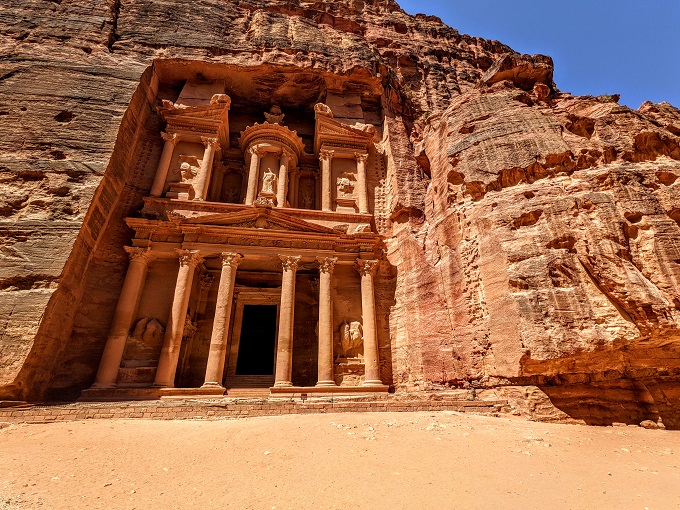
Arriving At Petra
Many people will visit Petra as part of a tour group, but if you’re making your own way there by rental car there’s a free parking lot near the entrance. Here’s a link to its location on Google Maps in case you want to get directions; be sure to also check out our post giving 10 tips for driving in Jordan.
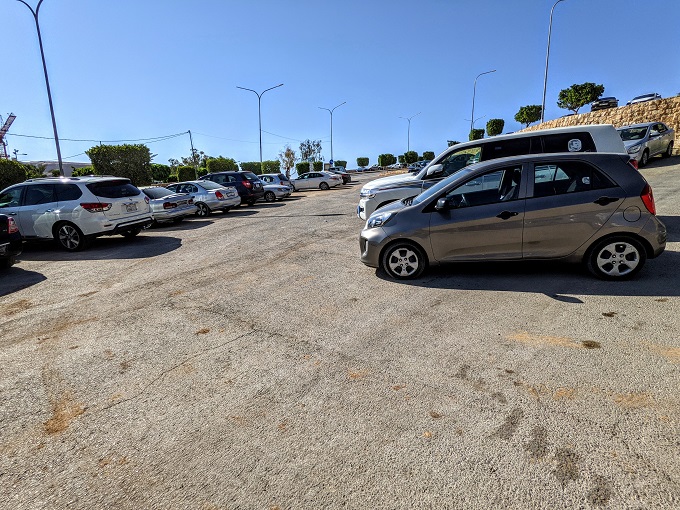
Walk down the hill 50-100 yards and you’ll come to the entrance with an I Love Petra sign outside.
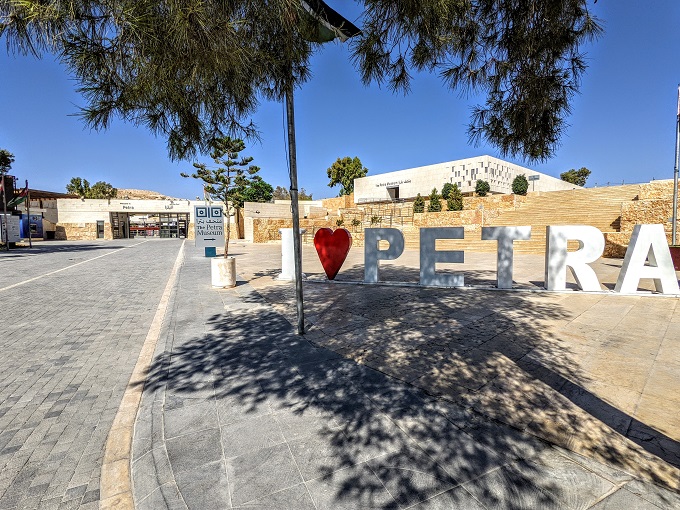
How To Buy Tickets For Petra
The Petra ticket office is on the left side of the entrance. You have to provide your passport when visiting (they scan it and hand it straight back), so be sure to bring that with you.
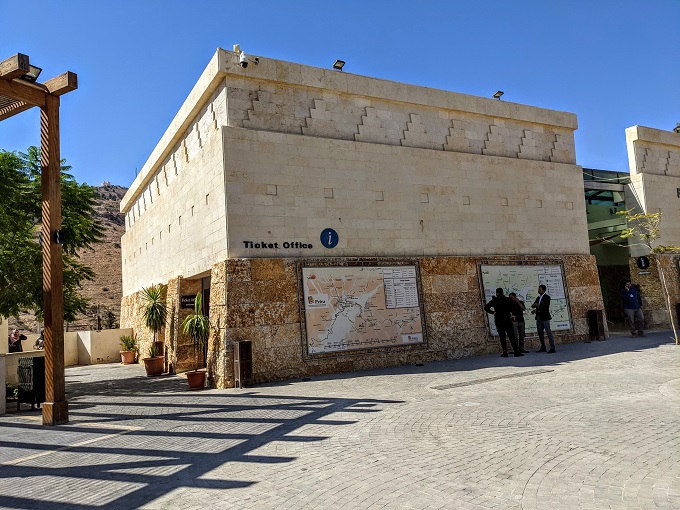
I think they might accept credit cards when purchasing tickets, but we’d already pulled cash out at our hotel just in case, so we paid with that. If you need any cash, there’s an ATM on site.
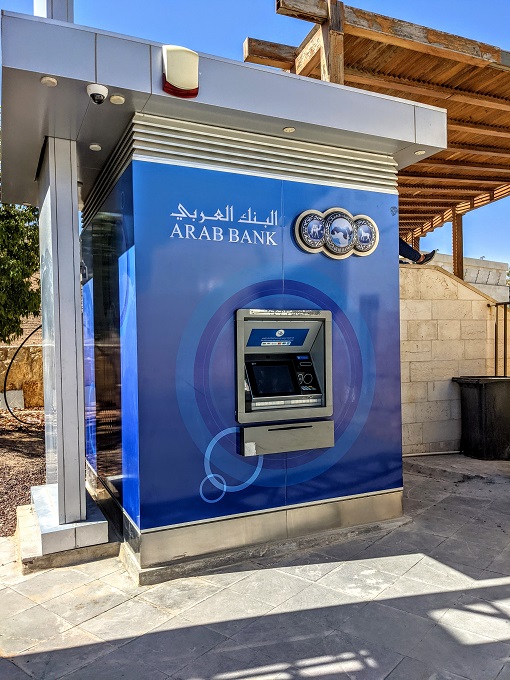
At the time of our visit (August 2021), Petra ticket prices were as follows:
- Tourists staying at least one night in Jordan
- One day ticket – 50 JOD (~70.50 USD)
- Two day ticket – 55 JOD (~77.50 USD)
- Three day ticket – 60 JOD (~84.50 USD)
- Tourists not staying overnight in Jordan
- Entrance ticket – 90 JOD (~127 USD)
We weren’t sure if we’d want to spend one or two days visiting Petra as we’d read conflicting reports online as to how long we’d need. Shae and I therefore decided to buy a two day ticket for 55 JOD. We figured that if we only spent one day there, we’d only be out 5 JOD per person. However, if we bought a one day ticket and subsequently decided we wanted to visit for a second day, we’d have to pay another 50 JOD. We ended up only visiting Petra for one day, but we’d still recommend that you buy a two day ticket if there’s any chance you’ll return for a second day.

How To Save Money On Tickets For Petra
If you’ll be staying in Jordan for at least three nights, there’s a way to save a decent amount of money on Petra ticket prices while also getting entry to many other attractions around Jordan. That’s because you’d be eligible to buy a Jordan Pass which bundles the cost of your visa, entry to Petra and other attractions into one ticket.
Here’s the pricing for a Jordan Pass as of September 2021:

To give you an idea of the savings on offer, a Jordanian entry visa currently costs 40 JOD. If you bought a one day entrance ticket for Petra separately, that would cost you 50 JOD, meaning you’d be spending a total of 90 JOD.
That’s what Shae and I did and so we spent a total of 180 JOD (~254 USD) between us. I’d forgotten that I’d previously read about the Jordan Pass. If I’d remembered its existence, we would’ve saved 35-40 JOD (~49.50 – ~56.50 USD) because we were staying in Jordan for more than three nights and so could’ve taken advantage of the Jordan Wanderer or Jordan Explorer packages.
In fact, we’d have saved even more than that because we’d have also saved on entry fees for other attractions in Jordan we paid to visit like Shobak Castle and the Museum at the Lowest Place on Earth. So don’t make my mistake – get a Jordan Pass if you’re visiting Jordan for 3+ nights and will be visiting Petra – it’s guaranteed to save you money seeing as it also includes the cost of your visa.
Petra Entrance Information
Anyway, back to our visit to Petra. After buying our (more-expensive-than-they-could’ve-been) tickets, we picked up a free guide which included a map along with some brief information about all of the main sights in Petra. Our guide was in English, but they had guides for many other languages available.
Outside the ticket office was a much larger map of Petra, along with information about the various trails you can take.
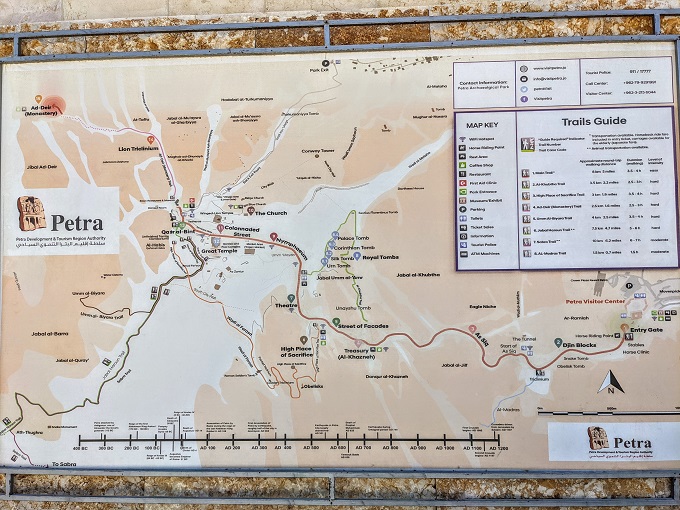

Something important to be aware of is that some of the trails require a guide in order to be able to hike it. That’s denoted by three downward-pointing chevrons on the above trail guide. On the trails guide shown above, it says trails 2-8 all require a guide, although trail 1 – the Main Trail – can be self-guided.
However, I’m a little confused by that. When researching this beforehand, I’d come across the following information on the official Visit Petra website:
- No guide required:
- Al Kubtha Trail
- Ad Deir – Main Trail
- High Place
- The Main Trail
- Guide required:
- Ad Deir – The Back Route
- Ad Deir to Kharubat Al-Fajjah
- Beidha – The First Trail
- Beidha – The Second Trail
I’m inclined to believe the information I found online rather than the sign in the photo above. Other than that trail guide shown above, there was nothing on site suggesting you had to have a guide to hike up to the Monastery (the Ad Deir trail). We didn’t see any other visitors on that trail with a guide, other than a couple of people who rode up on donkeys and even then I don’t think their guide was an official guide.
There was also a sign listing some tips and tricks when visiting Petra.
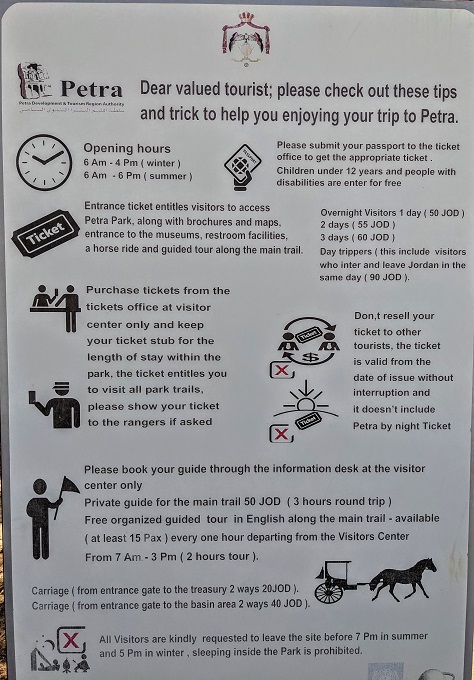
Main Trail To The Siq
With our tickets in hand, we started walking down the Main Trail towards the Siq. You can ride a horse down to the Siq’s entrance, the cost of which is included in your ticket price – you just have to tip the horse’s owner.
Shae and I decided to pass on that opportunity on the way down, choosing to walk the length of it instead. The paper guide we’d picked up suggested there were a few things to see along the way, so we figured walking would give us an opportunity to stop and see those more easily than if we were on horseback.
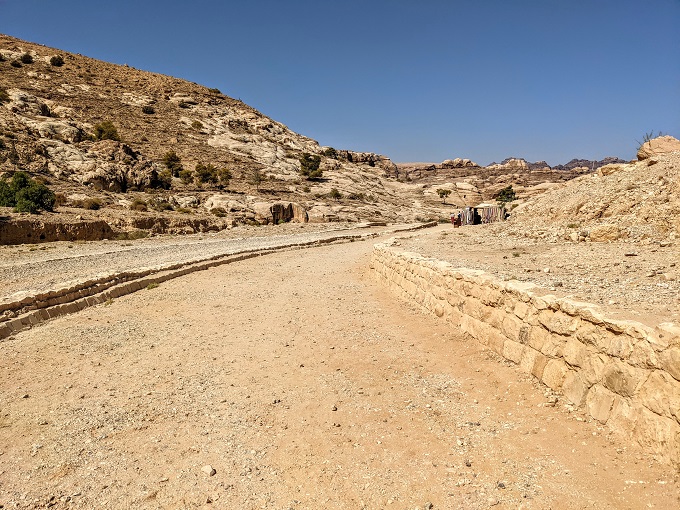
Soon enough we saw the three Djinn blocks on the right which are square monuments. A djinn is a spirit and it was believed that spirits lived in these blocks.
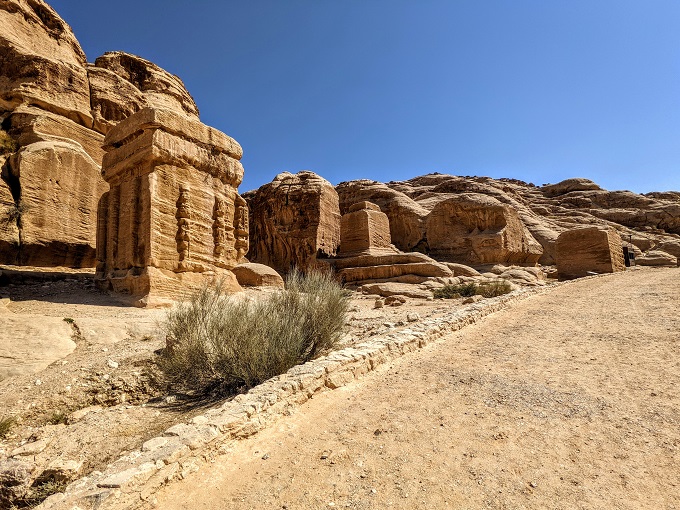
On the opposite side of the trail was the Obelisk Tomb. This has four tall pyramids on top and was carved in the 1st century AD.
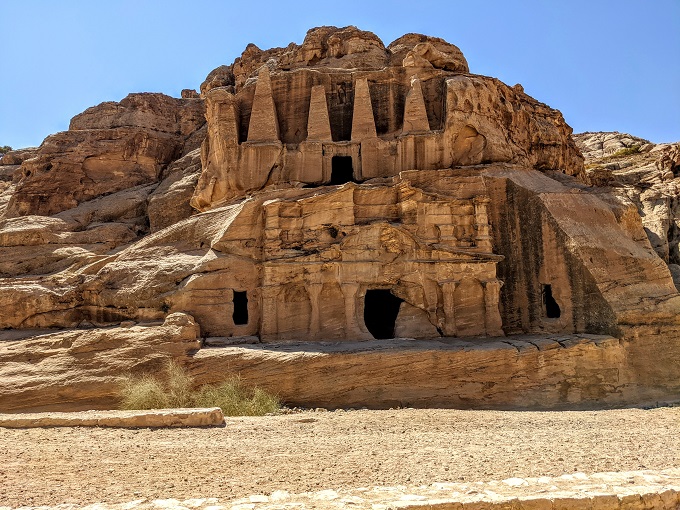
The Siq
The Siq is a canyon leading to Petra which was originally formed by a geological fault. It’s about 0.75 miles long and provided some much-appreciated shade as we walked through it. It was only 10:30am by the time we started walking down the Siq, but it was already pretty hot.
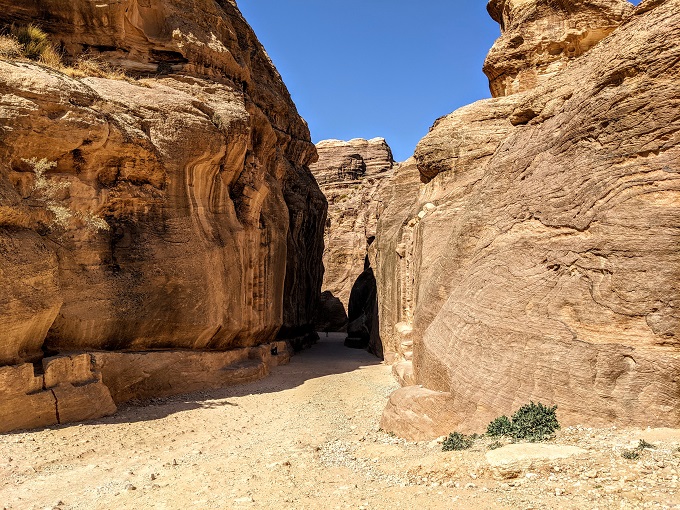
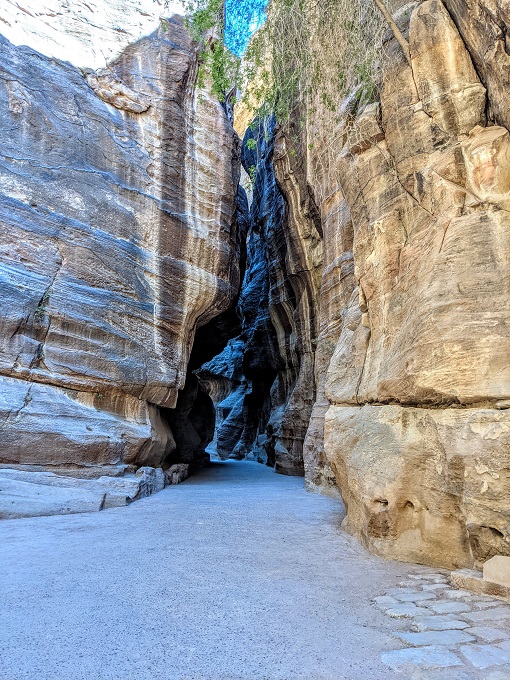
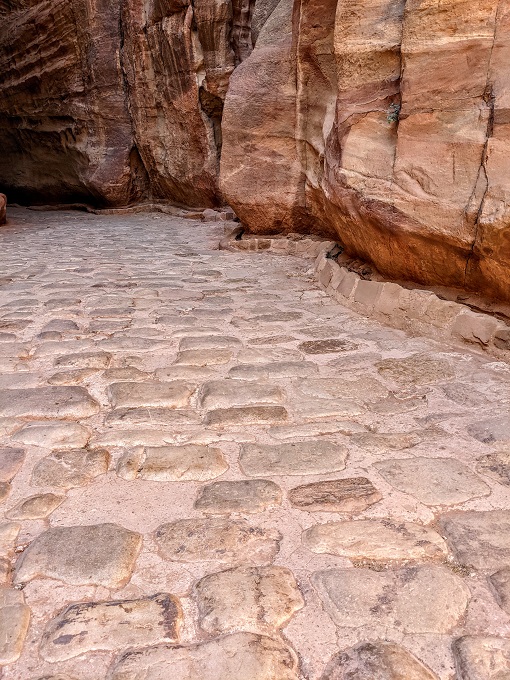
While walking through the Siq there were some carvings along the canyon walls. That included Sabinos Alexandros Station which were stone blocks carved by Sabinos to honor Dusares, the god of Adraa.

Treasury (Al-Khazneh)
As you come to the end of the Siq, you’ll catch a glimpse of perhaps the most well-known structure at Petra – the Treasury (also known as Al-Khazneh).
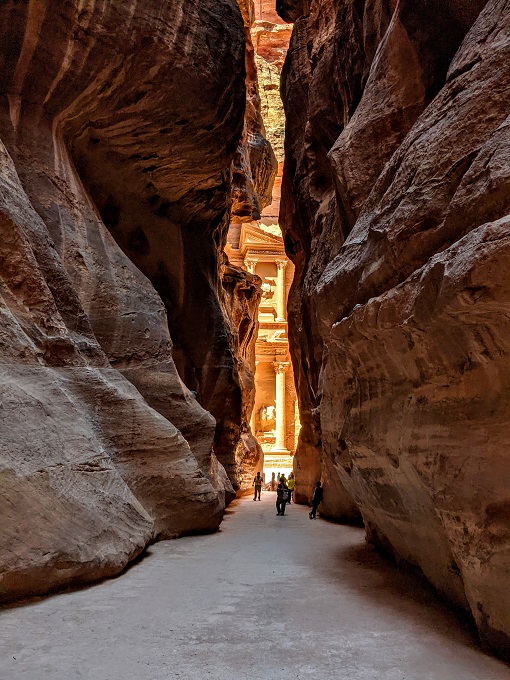
The Treasury towers above you when walking out into the courtyard in front of the building.

COVID was still impacting tourism in Jordan when we visited in August 2021, so Petra was significantly quieter than it would be during normal times. That’s obviously a negative state of affairs for people involved in the tourist industry in Jordan, but for tourists like Shae and I it meant we were able to get unobstructed photos of the Treasury which probably wouldn’t be possible outside of COVID times.
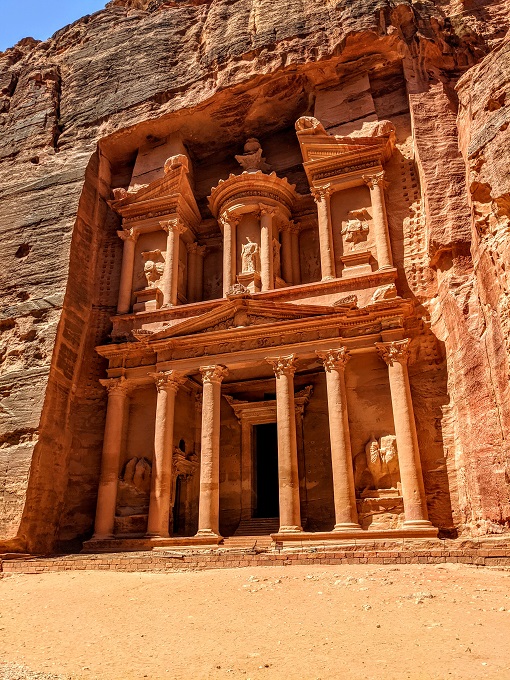
The Treasury is an impressive piece of architecture and is in excellent condition, especially considering it’s thought to date back to the 1st century AD.
The fact that it’s called the Treasury made me think it was used as a bank of some sorts. That’s not the case though – it was the mausoleum for King Aretas IV of the Nabateans. There are different legends as to why it’s now known as the Treasury, with one legend saying that the urn atop the Treasury contains an ancient Pharaoh’s treasure.
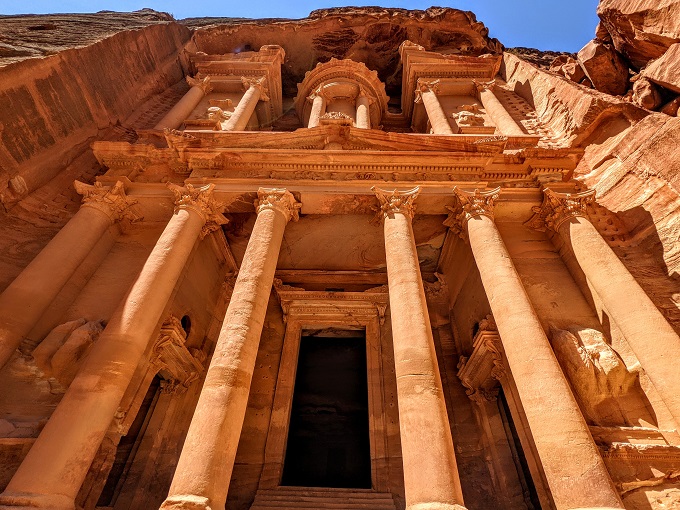
Street Of Facades
The Main Trail continued off to the right of the Treasury and led through to the Street of Facades.
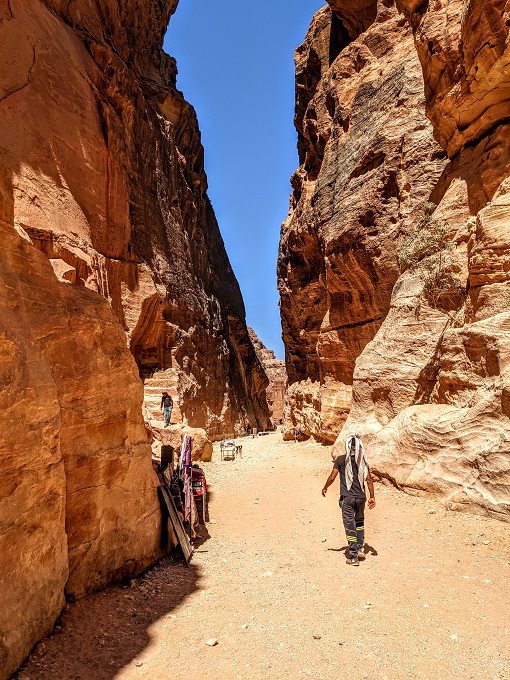
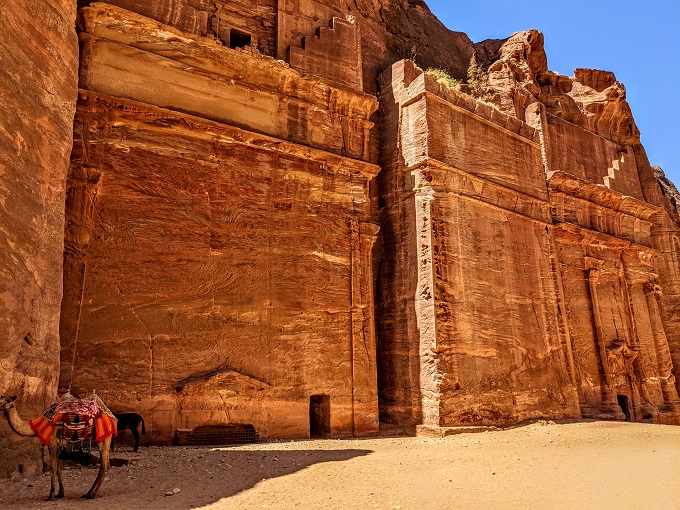
The Street of Facades has a number of buildings carved into the rock, along with many tombs.
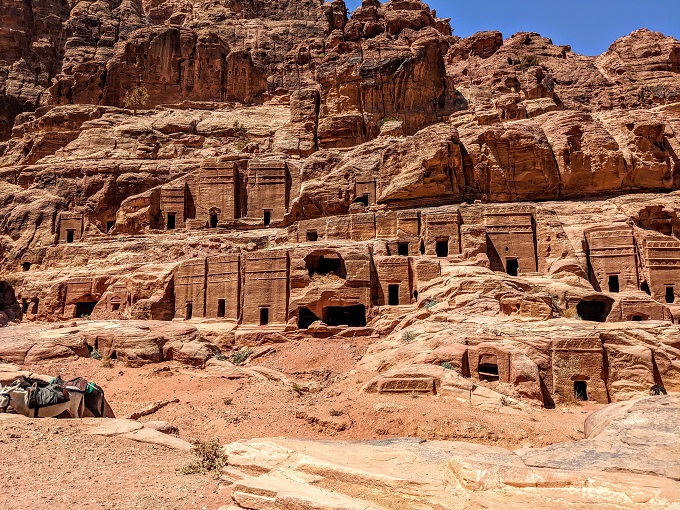
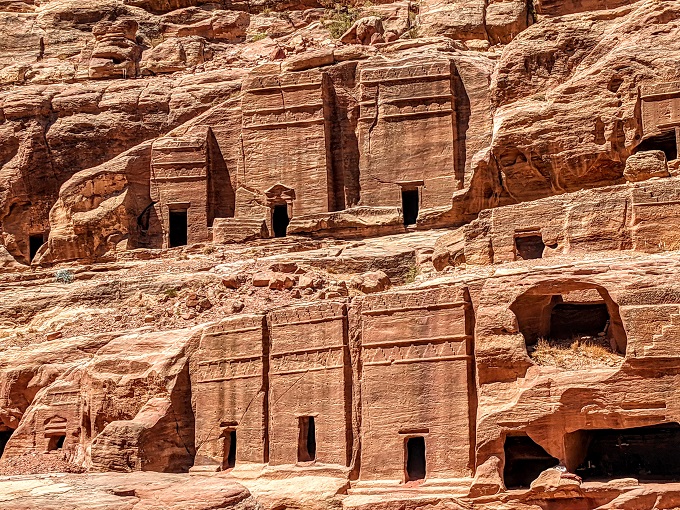
This is about 1.5 miles from the entrance, so by this point you might be hungry and/or thirsty. If so, you can get some refreshments from the Why Not Shop.
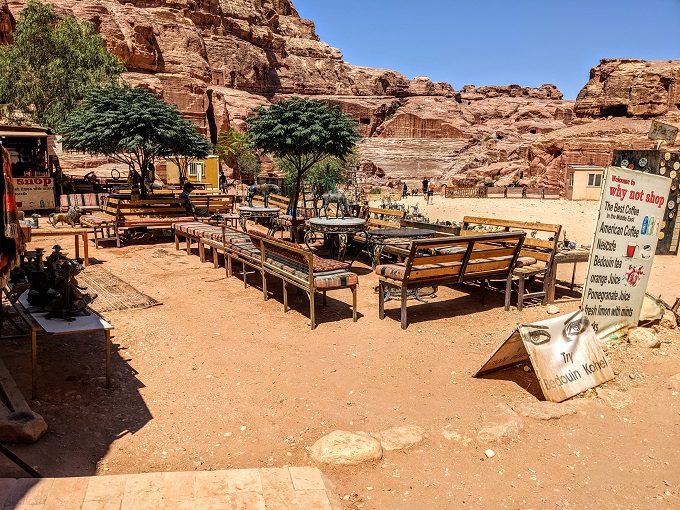
There are also restrooms available in this part of the city.
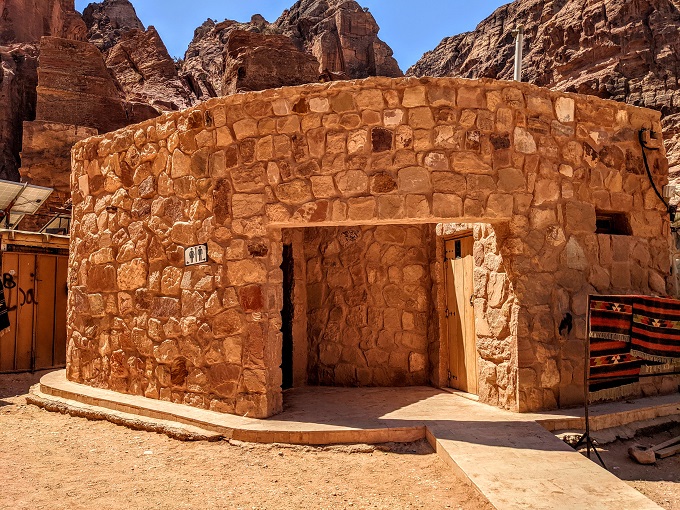
The Theatre
A short distance further up the Main Trail was the Theatre. This is carved into the mountain beneath the High Place of Sacrifice and contains three tiers of seating.
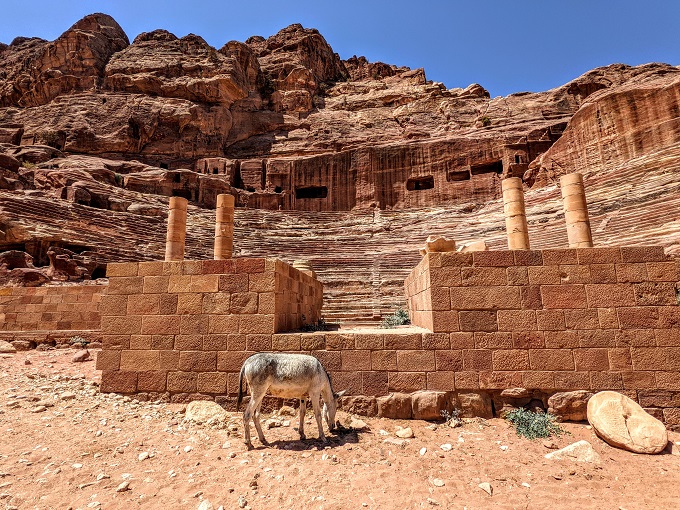
The Theatre is so large that it could seat 4,000 spectators along its numerous seating rows.
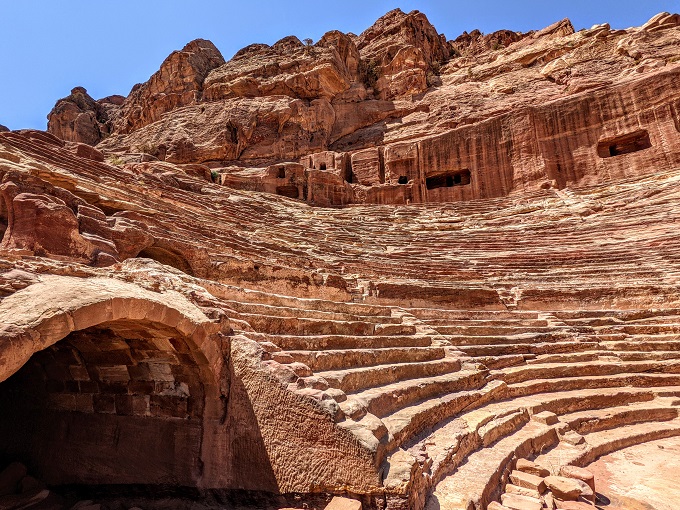
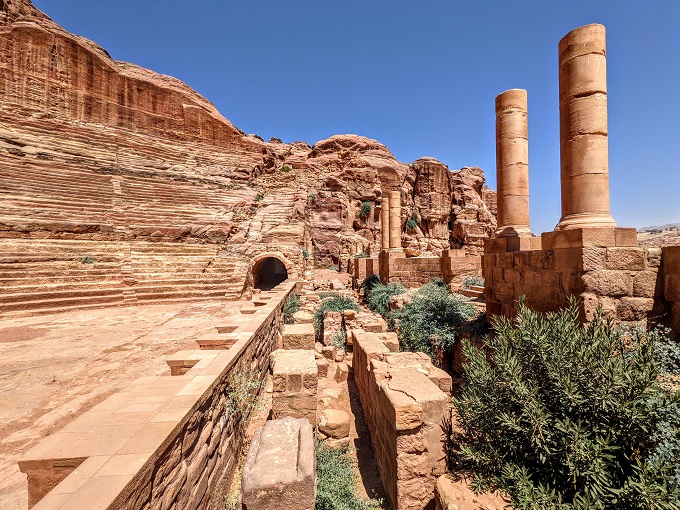
The Royal Tombs
After another short walk down the Main Trail we came upon the Royal Tombs on the right.
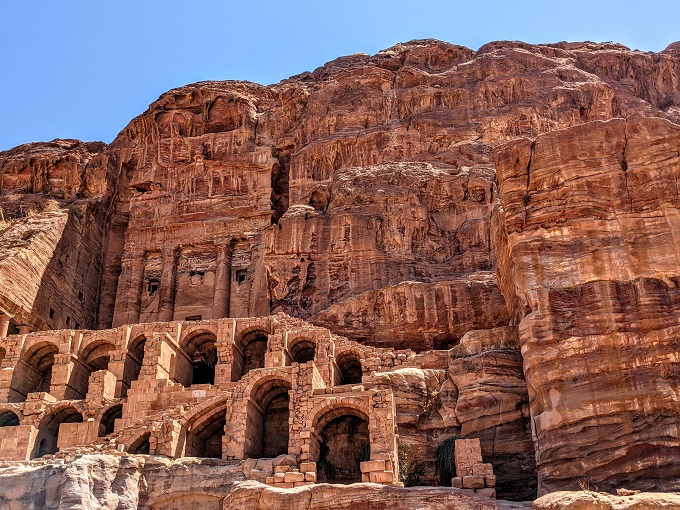
There are four tombs making up the Royal Tombs – the Urn Tomb, Silk Tomb, Corinthian Tomb and Palace Tomb.
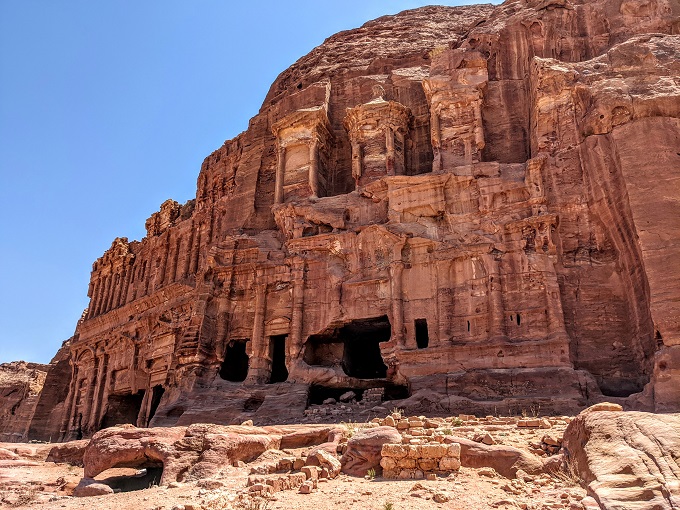
Nymphaeum
Next up was the Nymphaeum which was once a semi-circular public fountain. It’s now shaded by a 450 year old wild pistachio tree.
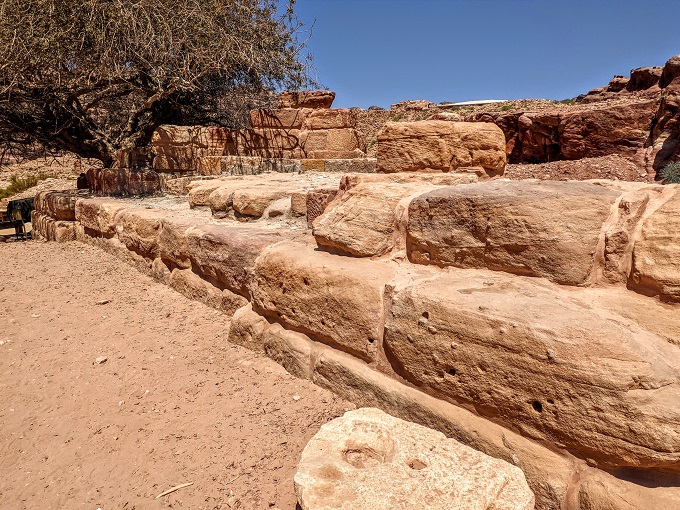
The Colonnaded Street
The Main Trail continues down the Colonnaded Street, so named due to the row of columns that once lined the street (and still do at one point).
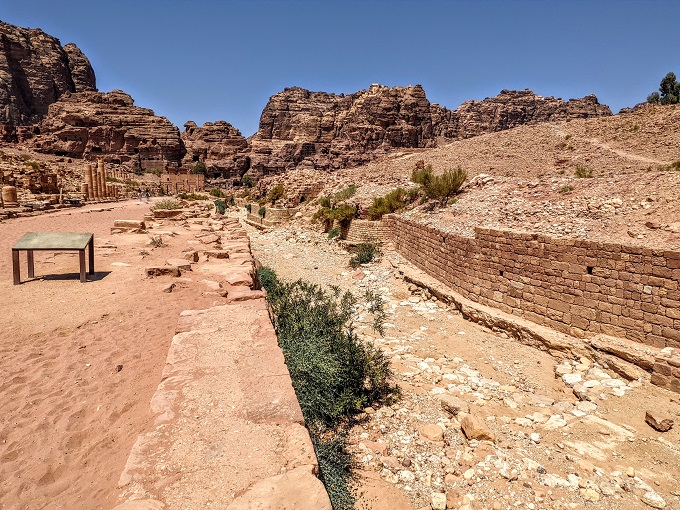
The Colonnaded Street was once one of the main shopping thoroughfares in Petra.
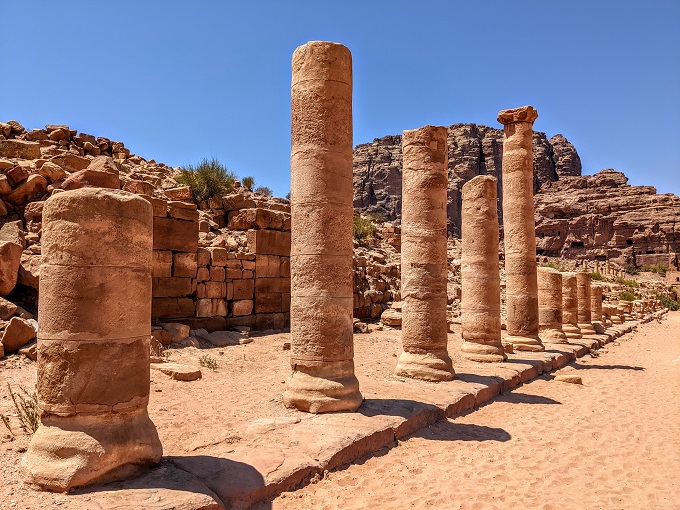
Great Temple
On the left side of the Colonnaded street was the Great Temple.
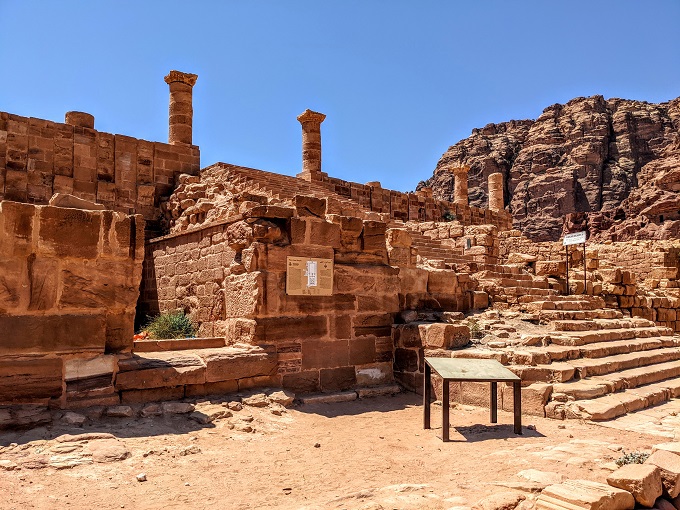
This was once an enormous temple, with the entire complex spanning almost 38,000 sq ft.
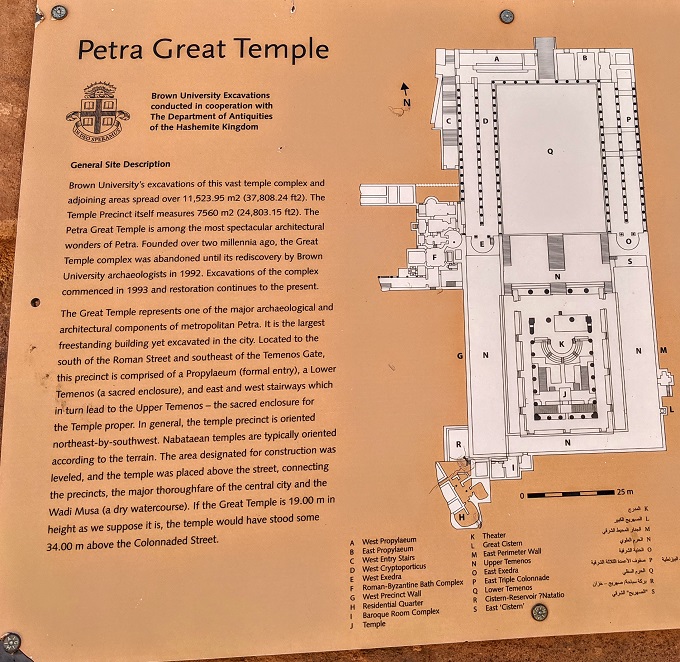
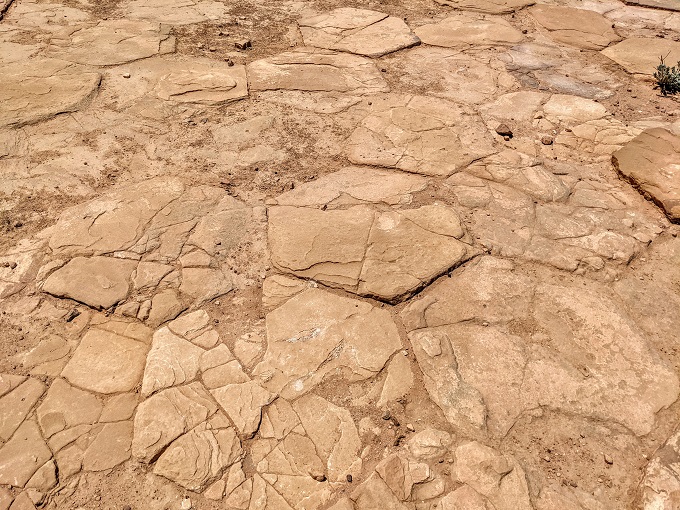
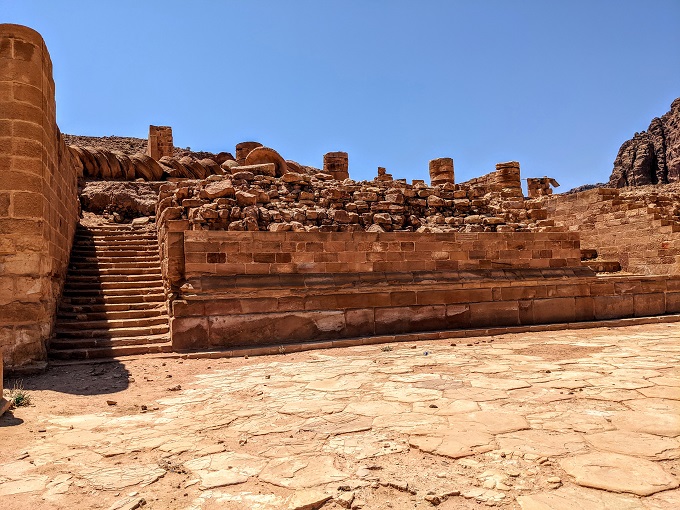
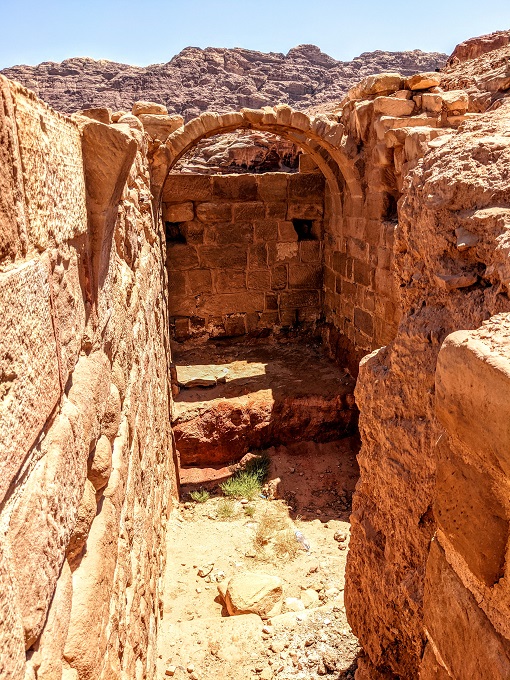
Viewing the Great Temple at ground level doesn’t give as good a sense as to how enormous it was. Our paper guide had a birds eye view photo of it which gave a much better idea of the complex’s size.
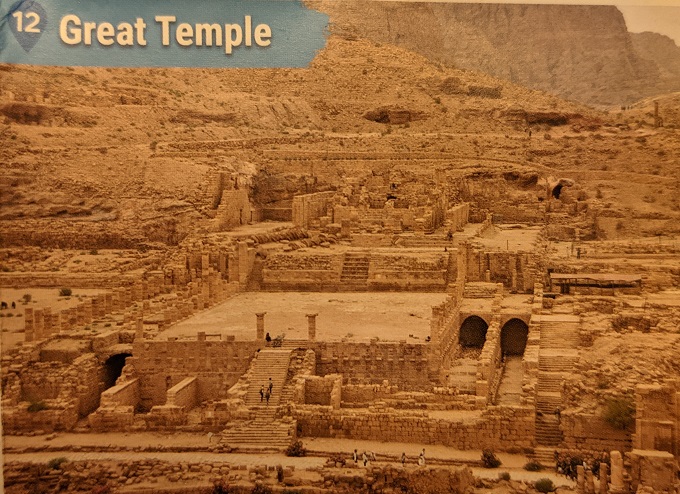
Shae and I stopped in the shade for a couple of minutes while she switched out lenses on her camera. While doing that, she made a new friend. A donkey had been waiting in the shade nearby; he walked over and seemed pleased to get some attention from Shae.
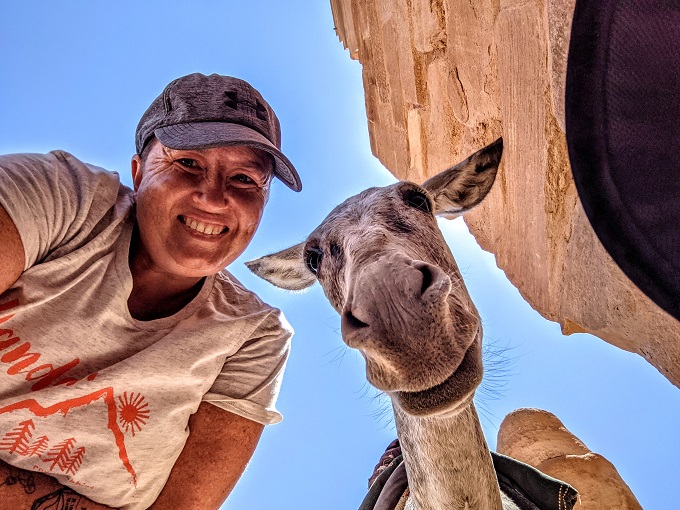
Qasr al-Bint
Towards the end of the Main Trail was Qasr al-Bint, a temple which was even more important than the Great Temple.
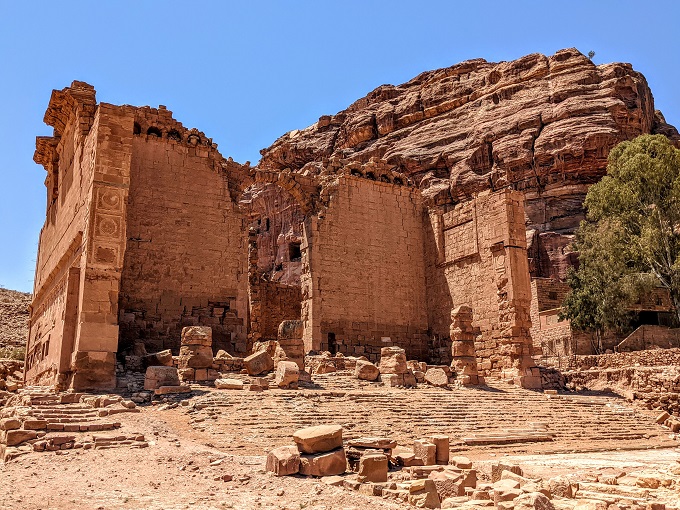
This temple dates back to the 1st century AD and was thought to house gods and goddesses.
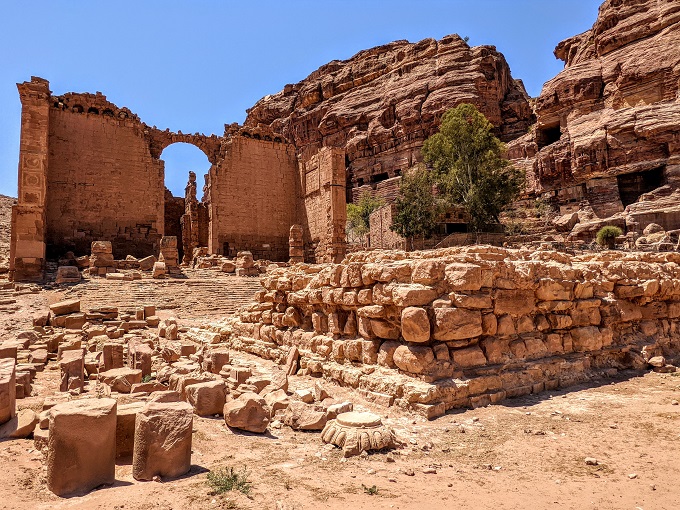
Basin Restaurant
At the very end of the Main Trail you’ll find Basin Restaurant. At this point you’ll have walked ~2.5 miles. The Monastery (Ad-Deir) trail is another 0.8 miles uphill, so if you don’t have much water on you, you’ll want to stock up here, or at least have something to drink first.
We still had plenty of water on us, so we decided to stop off at Basin Restaurant on our way back and continued on our way up to the Monastery.

Monastery (Al Deir)
Visiting the Monastery is well worth the effort, but be aware – it’s a lot of effort! You have to walk up 800+ steps and there’s not much shade along the way.
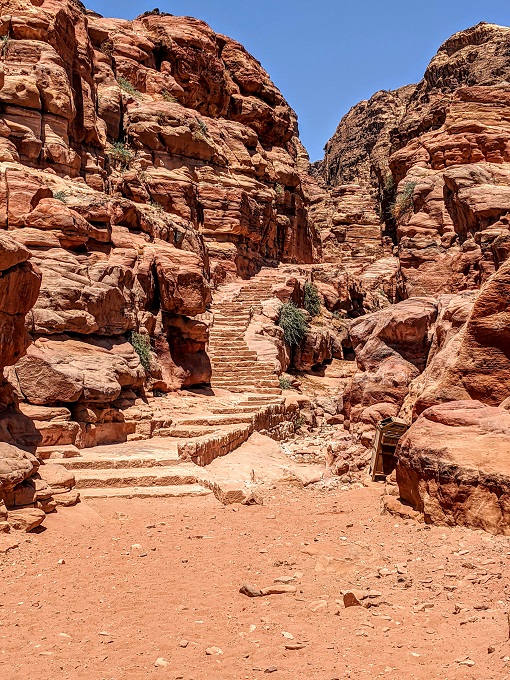
There are several stalls on the way up and Shae got sucked into one by accepting some Arabic tea. We wanted to get a couple of souvenir gifts anyway, so we bought those from the lady’s stall as she had what we were looking for.

When approaching the Ad Deir trail, several people had tried to convince us to ride up on their donkeys because they said it would take us 90 minutes to hike to the top otherwise. That didn’t end up being true; even with several breathers in what little shade there was and the stop at the stall along the way, we made it to the Monastery within about 45 minutes.

The Monastery is 154 ft wide and 158.5 ft high which makes it even larger than the Treasury. A couple of people walked across the front of it while I took a photo which was actually kind of useful as it gives a better sense of its size.
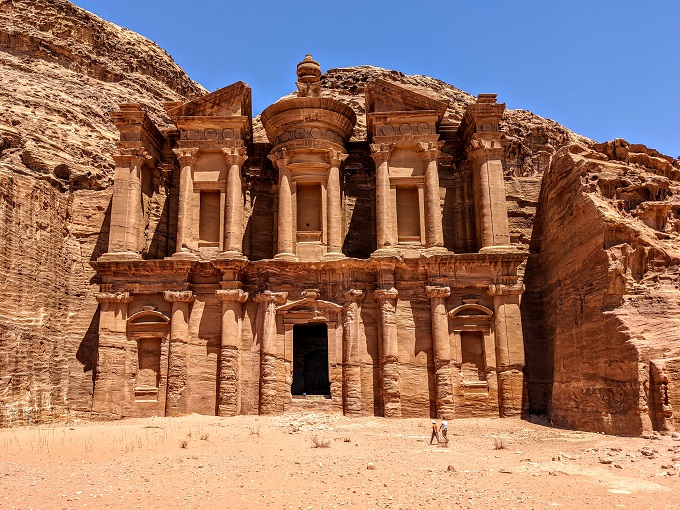
After hiking up that many steps, you might need some refreshment. Well, good news – there’s a cafe at the top which directly faces the Monastery and provides some much-needed shade.
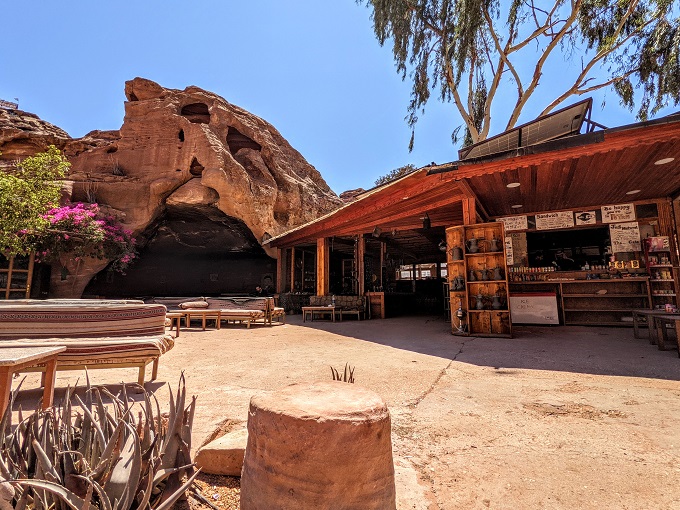
If your legs haven’t turned to jelly by this point, there are some extra steps you might want to walk up. That’s because there are some overlooks in the distance that provide views of the Monastery at greater elevation.
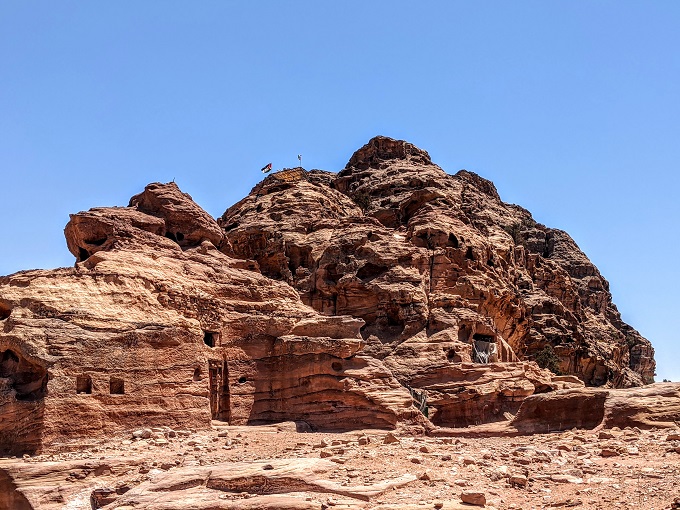
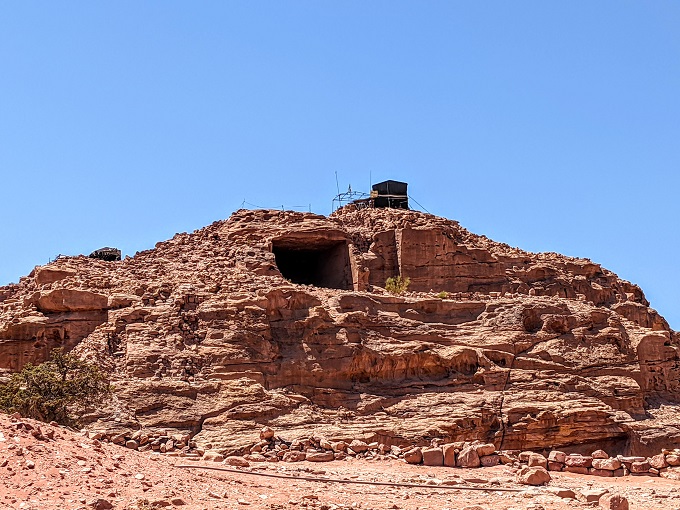
Having walked all that way already, we didn’t want to miss out on the additional vantage point and so we walked up to one of the overlooks.
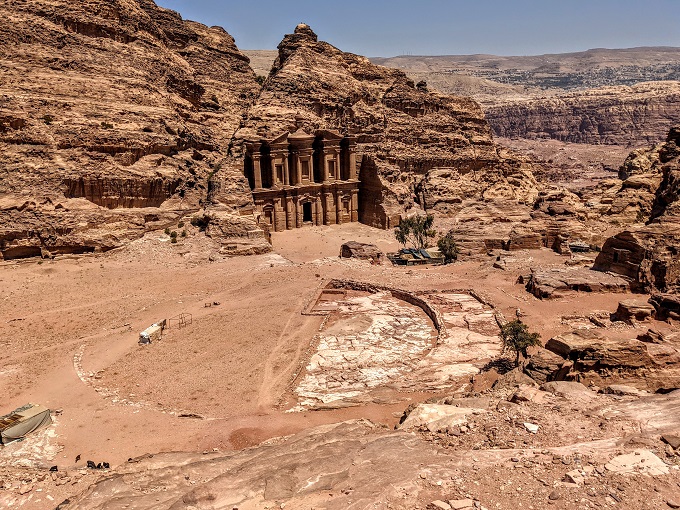
The Monastery was originally used as a religious meeting place after being built in the 2nd century AD. It was later used as a Christian chapel which is why it’s now known as the Monastery.
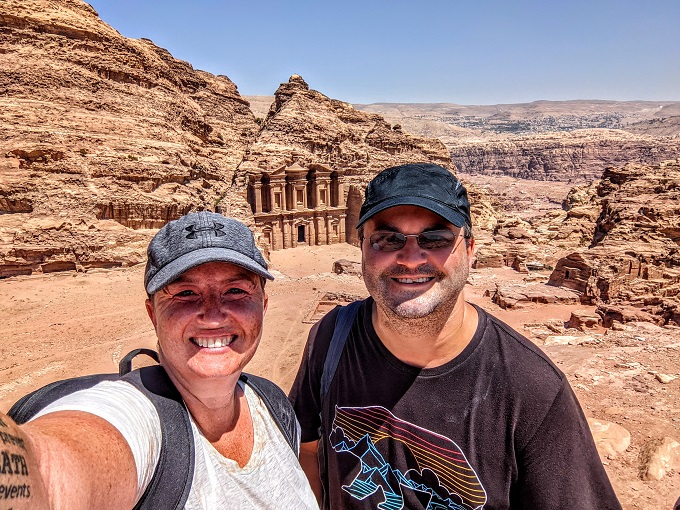
On the opposite side of the overlook were some nice views of the mountains.
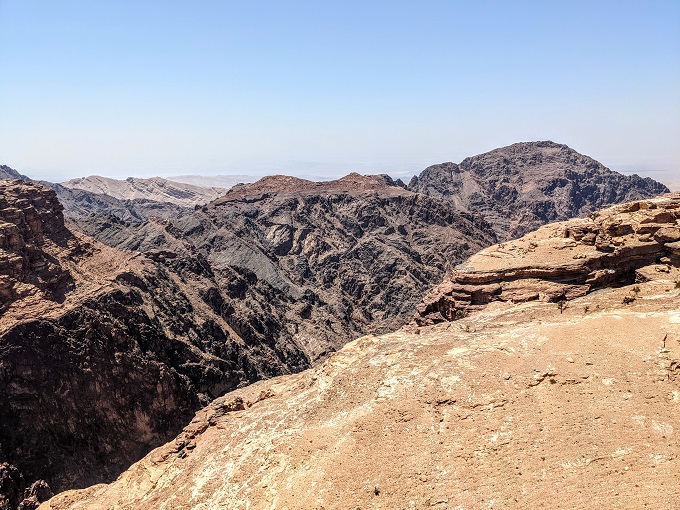
Basin Restaurant
After spending some time up at the Monastery, Shae and I headed back down all the steps and stopped at Basin Restaurant for drinks. Having climbed all that way, we felt like we deserved something a little stronger than the water we’d been drinking all day, so Shae got a glass of wine and I ordered a beer. We also shared a soda and bought another large bottle of water to go as we were running low. We’d started the day with 5+ liters of water, so that should give you a sense of how much water it’s worth bringing when visiting Petra.
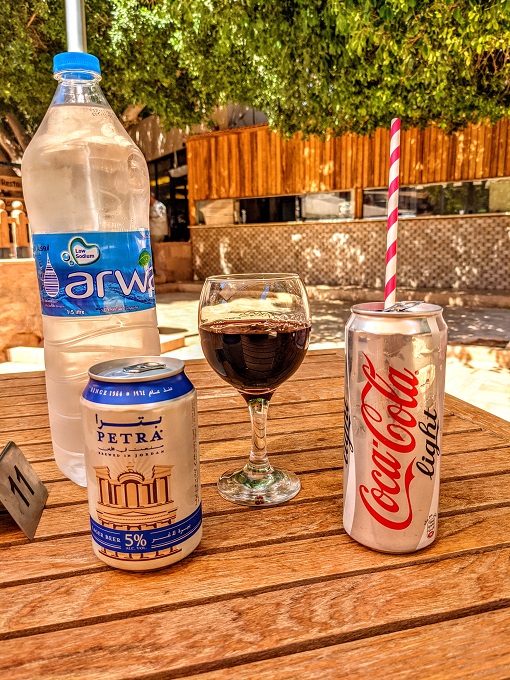
Returning Along The Main Trail
Even if you decide not to walk all the way up to the Monastery, I’d recommend walking all the way to the end of the Main Trail if you can. That’s because the walk back along the trail gave us a completely different perspective of Petra.
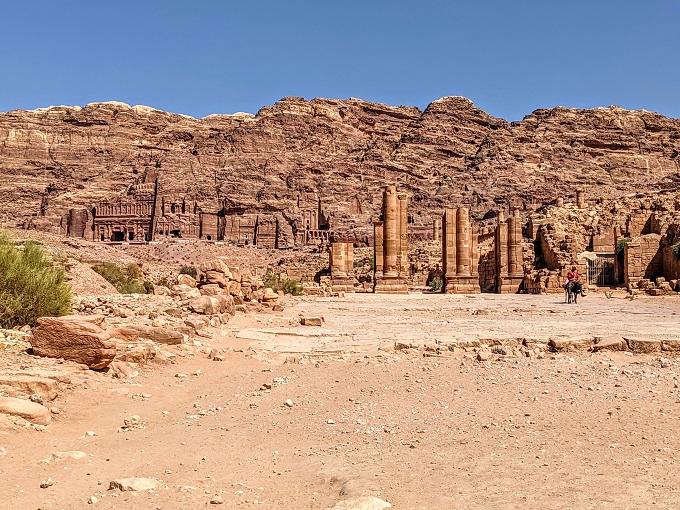
When walking down the Main Trail earlier that day, all the carvings and monuments were close by. When walking back up the Main Trail that afternoon, we approached everything from a distance which provided much different vantage points.
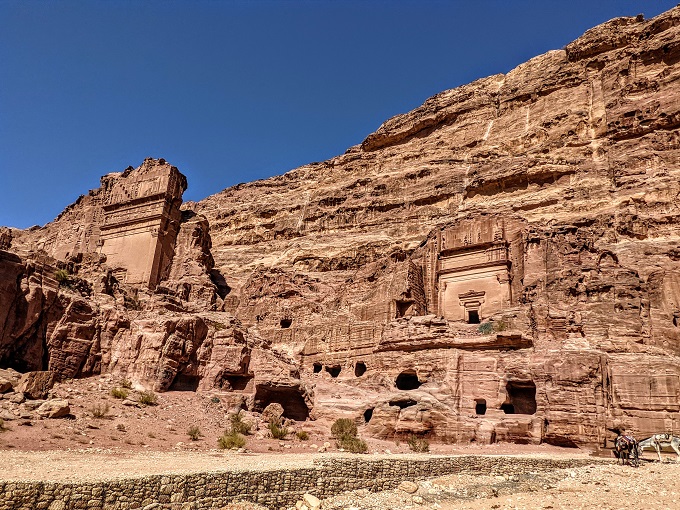
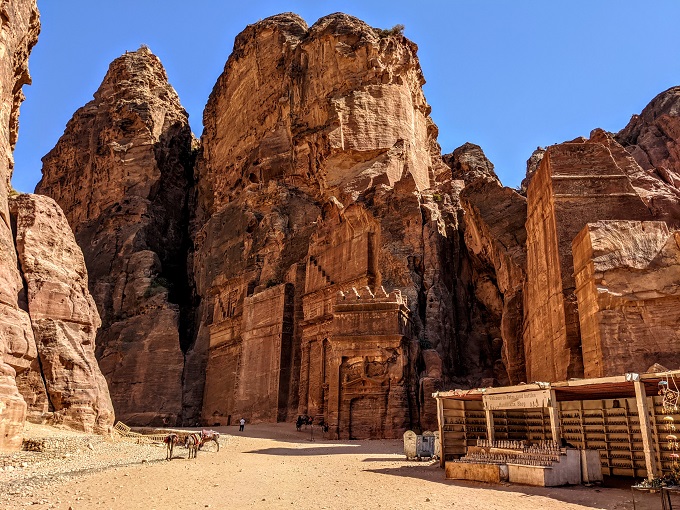
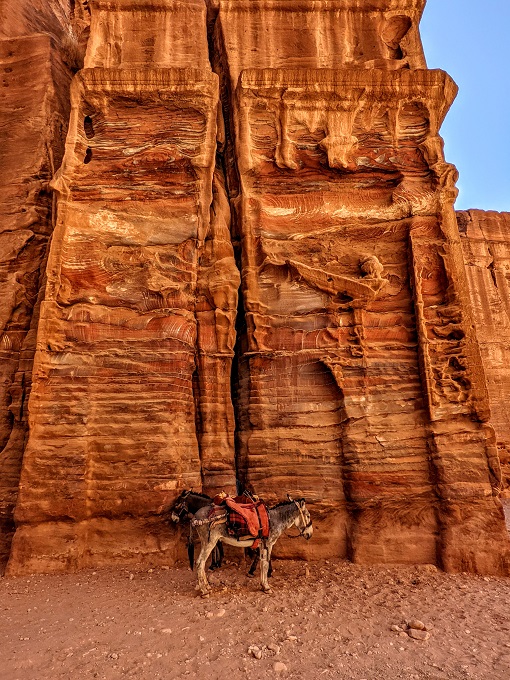
It’s worth stopping back by the Treasury on your way back up the Main Trail as the waning sunlight changes its color towards the end of the day. Unfortunately there were some police officers who decided that sitting at the base of the Treasury was the best place for them to hang out. That meant we weren’t able to get any photos without them in it, so we were glad we’d at least been able to get some photos of the Treasury that morning sans people.
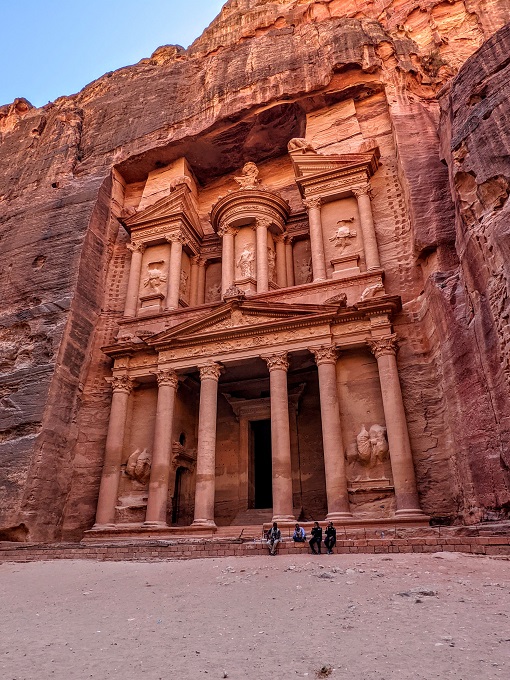
Horse Ride
After walking back through the Siq, there were a lot of people waiting with their horses offering to give us a ride back up. Again, these particular rides are included as part of your entry fee, although you’re expected to tip the horse’s owner.
Having walked 8+ miles that day (after accounting for the side trails and overlook at the Monastery), we decided to take advantage of the opportunity and rode horses back up the hill.
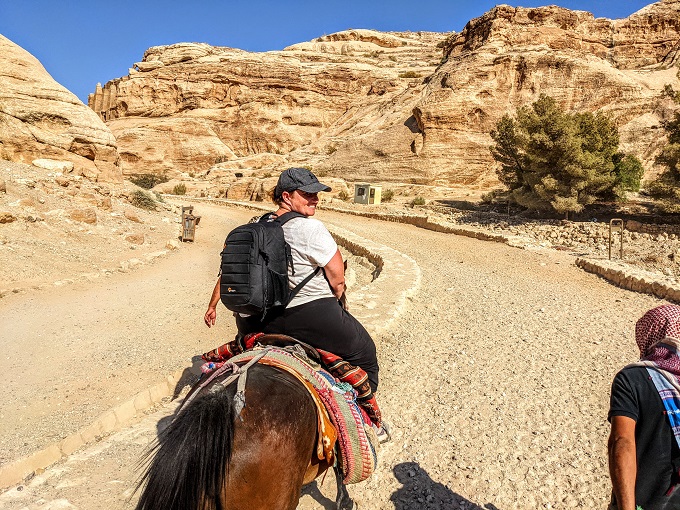
I’d never ridden a horse before, so it was fun getting to have that experience.

Final Thoughts
I’ll be honest – after our first hour or so at Petra, Shae and I weren’t as blown away as we thought we’d be. It’s not that the monuments like the Treasury weren’t impressive; it’s more that they’d been so hyped up beforehand that we were expecting even more.
However, as the day went on, Petra grew on us more and more. It was actually the walk back up the Main Trail that sealed it for us. Despite the fact that we were seeing the city’s archaeological sights for a second time that day, it felt like we were seeing them anew due to the fact that we were viewing them from a completely different perspective.
We were therefore glad to have had the opportunity to explore Petra and see most of the main sites. There were a few parts we didn’t have the energy to explore that day like the High Place of Sacrifice and some of the other side trails to other sections like the Church, but I feel like we got to see as much of Petra as we could during our 6.5 hours there.
Check Out All The Posts From Our Dubai/Egypt/Jordan Trip
- It’s Time For Shae’s Secret Birthday Extravaganza!
- Flight Review: Emirates First Class – Chicago (ORD) To Dubai (DXB)
- Hotel Review: Grand Hyatt Dubai (1 Bedroom Grand Suite)
- Awesome Dubai Desert Safari For Shae’s 40th Birthday
- 1 Week In Dubai: Here’s What We Did
- Hotel Review: Ramses Hilton In Cairo, Egypt
- Exploring Babylon Fortress In Old Cairo, Egypt
- Visiting The Pyramids Of Giza In Cairo, Egypt
- Hotel Review: Marriott Mena House In Cairo, Egypt
- 6 Days In Cairo, Egypt – Here’s What We Did
- Our Dead Sea Experience: Floating, Mud & Tequila Shots!
- Hotel Review: Hilton Dead Sea Resort & Spa, Jordan
- 10 Tips For Driving In Jordan
- Visiting Petra In Jordan – One Of The New 7 Wonders Of The World
- Hotel Review: Petra Marriott, Jordan
- 1 Week In Jordan – Here’s What We Did
- Flight Review: Turkish Airlines Business Class – Istanbul (IST) To Chicago (ORD)
- Hotel Review: Hilton Chicago O’Hare Airport, IL
- Spending Breakdown: 3 Weeks In Dubai, Egypt & Jordan – Here’s What It Cost
Excellent review and tips. Muscle memory is really a thing — my thighs are aching and I haven’t been to the Monastery in 25 years!
Thanks! That climb up is pretty brutal.
Great write-up of the experience— thanks!
Thanks! Hope you get a chance to visit 🙂